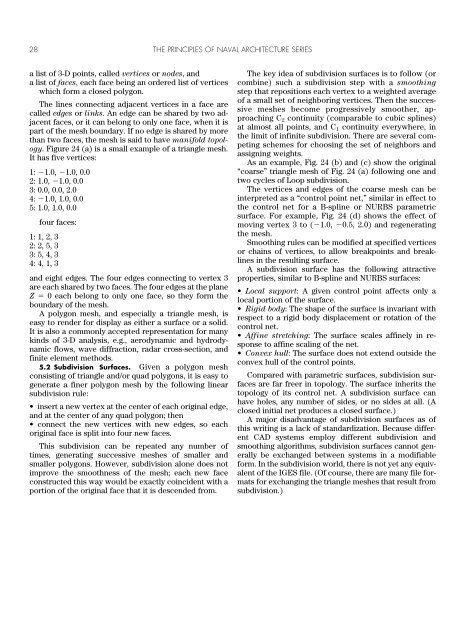The Geometry of Ships
You also want an ePaper? Increase the reach of your titles
YUMPU automatically turns print PDFs into web optimized ePapers that Google loves.
28 THE PRINCIPLES OF NAVAL ARCHITECTURE SERIES<br />
a list <strong>of</strong> 3-D points, called vertices or nodes, and<br />
a list <strong>of</strong> faces, each face being an ordered list <strong>of</strong> vertices<br />
which form a closed polygon.<br />
<strong>The</strong> lines connecting adjacent vertices in a face are<br />
called edges or links. An edge can be shared by two adjacent<br />
faces, or it can belong to only one face, when it is<br />
part <strong>of</strong> the mesh boundary. If no edge is shared by more<br />
than two faces, the mesh is said to have manifold topology.<br />
Figure 24 (a) is a small example <strong>of</strong> a triangle mesh.<br />
It has five vertices:<br />
1: 1.0, 1.0, 0.0<br />
2: 1.0, 1.0, 0.0<br />
3: 0.0, 0.0, 2.0<br />
4: 1.0, 1.0, 0.0<br />
5: 1.0, 1.0, 0.0<br />
four faces:<br />
1: 1, 2, 3<br />
2: 2, 5, 3<br />
3: 5, 4, 3<br />
4: 4, 1, 3<br />
and eight edges. <strong>The</strong> four edges connecting to vertex 3<br />
are each shared by two faces. <strong>The</strong> four edges at the plane<br />
Z 0 each belong to only one face, so they form the<br />
boundary <strong>of</strong> the mesh.<br />
A polygon mesh, and especially a triangle mesh, is<br />
easy to render for display as either a surface or a solid.<br />
It is also a commonly accepted representation for many<br />
kinds <strong>of</strong> 3-D analysis, e.g., aerodynamic and hydrodynamic<br />
flows, wave diffraction, radar cross-section, and<br />
finite element methods.<br />
5.2 Subdivision Surfaces. Given a polygon mesh<br />
consisting <strong>of</strong> triangle and/or quad polygons, it is easy to<br />
generate a finer polygon mesh by the following linear<br />
subdivision rule:<br />
• insert a new vertex at the center <strong>of</strong> each original edge,<br />
and at the center <strong>of</strong> any quad polygon; then<br />
• connect the new vertices with new edges, so each<br />
original face is split into four new faces.<br />
This subdivision can be repeated any number <strong>of</strong><br />
times, generating successive meshes <strong>of</strong> smaller and<br />
smaller polygons. However, subdivision alone does not<br />
improve the smoothness <strong>of</strong> the mesh; each new face<br />
constructed this way would be exactly coincident with a<br />
portion <strong>of</strong> the original face that it is descended from.<br />
<strong>The</strong> key idea <strong>of</strong> subdivision surfaces is to follow (or<br />
combine) such a subdivision step with a smoothing<br />
step that repositions each vertex to a weighted average<br />
<strong>of</strong> a small set <strong>of</strong> neighboring vertices. <strong>The</strong>n the successive<br />
meshes become progressively smoother, approaching<br />
C 2 continuity (comparable to cubic splines)<br />
at almost all points, and C 1 continuity everywhere, in<br />
the limit <strong>of</strong> infinite subdivision. <strong>The</strong>re are several competing<br />
schemes for choosing the set <strong>of</strong> neighbors and<br />
assigning weights.<br />
As an example, Fig. 24 (b) and (c) show the original<br />
“coarse” triangle mesh <strong>of</strong> Fig. 24 (a) following one and<br />
two cycles <strong>of</strong> Loop subdivision.<br />
<strong>The</strong> vertices and edges <strong>of</strong> the coarse mesh can be<br />
interpreted as a “control point net,” similar in effect to<br />
the control net for a B-spline or NURBS parametric<br />
surface. For example, Fig. 24 (d) shows the effect <strong>of</strong><br />
moving vertex 3 to (1.0, 0.5, 2.0) and regenerating<br />
the mesh.<br />
Smoothing rules can be modified at specified vertices<br />
or chains <strong>of</strong> vertices, to allow breakpoints and breaklines<br />
in the resulting surface.<br />
A subdivision surface has the following attractive<br />
properties, similar to B-spline and NURBS surfaces:<br />
• Local support: A given control point affects only a<br />
local portion <strong>of</strong> the surface.<br />
• Rigid body: <strong>The</strong> shape <strong>of</strong> the surface is invariant with<br />
respect to a rigid body displacement or rotation <strong>of</strong> the<br />
control net.<br />
• Affine stretching: <strong>The</strong> surface scales affinely in response<br />
to affine scaling <strong>of</strong> the net.<br />
• Convex hull: <strong>The</strong> surface does not extend outside the<br />
convex hull <strong>of</strong> the control points.<br />
Compared with parametric surfaces, subdivision surfaces<br />
are far freer in topology. <strong>The</strong> surface inherits the<br />
topology <strong>of</strong> its control net. A subdivision surface can<br />
have holes, any number <strong>of</strong> sides, or no sides at all. (A<br />
closed initial net produces a closed surface.)<br />
A major disadvantage <strong>of</strong> subdivision surfaces as <strong>of</strong><br />
this writing is a lack <strong>of</strong> standardization. Because different<br />
CAD systems employ different subdivision and<br />
smoothing algorithms, subdivision surfaces cannot generally<br />
be exchanged between systems in a modifiable<br />
form. In the subdivision world, there is not yet any equivalent<br />
<strong>of</strong> the IGES file. (Of course, there are many file formats<br />
for exchanging the triangle meshes that result from<br />
subdivision.)



